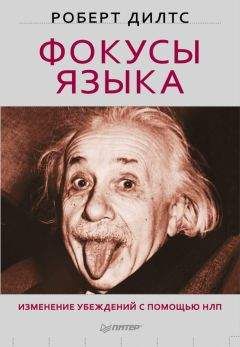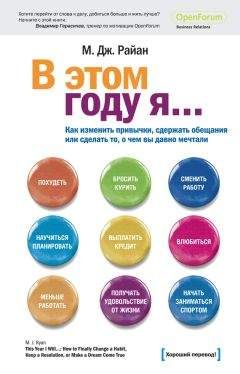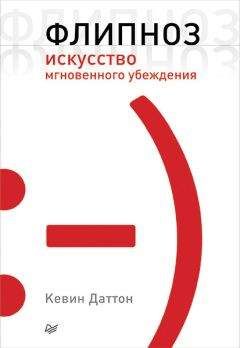Тим Халлбом - Убеждения и привычки. Как изменить?
Глава 5
1. See Richard Bandler and John Grinder, The Structure of Magic II (Palo Alto, CA: Science and Behavior Books, 1975), pp. 629–6.
Глава 6
1. See Robert Dilts, Richard Bandler, Judith DeLozier, Leslie Cameron– Bandler, and John Grinder, Neuro-Linguistic Programming, Vol. I: The Study of the Structure of Subjective Experience (Cupertino, CA: Meta Publications, 1979).
Глава 7
1. См. метод Симонтонов, описанный в главе 4.
2. See Shakti Gawain, Creative Visualization (Berkeley, CA: Whatever Publishing, 1978); Adelaide Bry, Visualization: Directing the Movies of Your Mind (New York: Harper & Row, 1979); Jose Silva, The Silva Mind Control Method (New York: Simon & Schuster, 1977); O. Carl Simonton and Stephanie Matthews-Simonton, Getting Well Again (New York: Bantam Books, 1978).
3. См. приложение A.
Глава 8
1. John N. Mackenzie, “The Production of the So-Called ‘Rose Cold’ by Means of an Artificial Rose,” American Journal of Medical Science 9 (1886), 45–57.
2. Peter Jaret, “Cell Wars,” National Geographic 169(6) (1986), 701–735.
3. Ivan Petrovich Pavlov, The Essential Works of Pavlov, ed. Michael Kaplan (New York: Bantam Books, 1965).
4. See Richard Bandler, Using Your Brain – For A Change (Moab, UT: Real People Press, 1985).
Список литературы
Anderson, J. Thinking, Changing, Rearranging: Improving Self-Esteem in Young People. Portland, OR: Metamorphous Press, 1988.
Andreas, C. and Andreas, S. Heart of the Mind. Moab, UT: Real People Press, 1989.
Andreas, C. and Andreas, T. Core Transformation. Moab, UT: Real People Press, 1994.
Andreas, S. and Andreas, C. Change Your Mind and Keep the Change. Moab, UT: Real People Press, 1987.
Bandler, R. Using Your Brain – For A Change. Moab, UT: Real People Press, 1985.
Bandler, R. and Grinder, J. The Structure of Magic I. Palo Alto, CA: Science and Behavior Books, 1975.
Bandler, R. and Grinder, J. The Structure of Magic II. Palo Alto, CA: Science and Behavior Books, 1976.
Bandler, R. and Grinder, J. Frogs into Princes. Moab, UT: Real People Press, 1979.
Bandura, A. “Self-efficacy: Toward a Unifying Theory of Behavioral Change,” Psychological Review 84 (1977), 1912–15.
Bridell, D. W., Rimm, D. C., Caddy, G. R., Krawitz, G., Sholis, D. and Wunderlin, R. J. “Effects of Alcohol and Cognitive Set on Sexual Arousal to Deviant Stimuli,” Journal of Abnormal Psychology 87 (1918), 4184–30.
Bry, A. Visualization: Directing the Movies of Your Mind. New York: Harper & Row, 1979.
Copra, D. Creating Health. Boston, MA: Houghton Mifflin, 1987.
Dilts, R. Roots of Neuro-Linguistic Programming. Cupertino, CA: Meta Publications, 1976.
Dilts, R. Applications of Neuro-Linguistic Programming. Cupertino, CA: Meta Publications, 1983.
Dilts, R. Changing Belief Systems with НЛП. Capitola, CA: Meta Publications, 1990.
Dilts, R. Strategies of Genius Vol. III. Capitola, CA: Meta Publications, 1995.
Dilts, R. The Encyclopedia of Systemic Neuro-Linguistic Programming. Scotts Valley, CA: НЛП University Press, 2000.
Dilts, R., Bandler, R., DeLozier, J., Cameron-Bandler, L., and Grinder. J. Neuro-Linguistic Programming, Vol. I: The Study of the Structure of Subjective Experience. Cupertino, CA: Meta Publications, 1979.
Dilts, R. and Hollander, J. НЛП and Life Extension: Modeling Longevity. Ben Lomond, CA: Dynamic Publications, 1992.
Dilts, R. and McDonald, R. Tools of the Spirit. Capitola, CA: Meta Publications, 1997.
Evans, F. J. “The Placebo Control of Pain,” in J. P. Brady, J. Mendels, M. T. Orne, and. W. Rieger (eds), Psychiatry: Areas of Promise and Advancement. New York: Spectrum, 1977, pp. xx-xx.
Evans, F. J. “Placebo Response: Relationship to Suggestibility and Hypnotizability,” Proceedings of the 77th Annual Convention of the American Psychological Association. Washington, DC: APA, 1969, pp. 8898–90.
Evans, F. J. “The Power of a Sugar Pill,” Psychology Today (April 1974), 555–9.
Jaret, P. “Cell Wars.” National Geographic 169(6) (1986), 7017–35.
Kirsch, I. “Response Expectancy as a Determinant of Experience and Behavior,” American Psychologist 40 (1985), 11891–201.
Lasagna, L., Mosteller, F., von Felsinger, J. M., and Beecher, H. K. “A Study of the Placebo Response,” American Journal of Medicine 16 (1954), 7707–79.
Mackenzie, J. N. “The Production of the So-Called ‘Rose Cold’ by Means of an Artificial Rose,” American Journal of Medical Science 9 (1886), 455–7.
Marlatt, G. A. and Rohsenow, D. J. “Cognitive Processes in Alcohol Use,” in N. K. Mello (ed.), Advances in Substance Abuse: Behavioral and Biological Research. Greenwich, CT: JAI Press, 1980, pp. 1591–99.
Pavlov, I. P. The Essential Works of Pavlov, ed. Michael Kaplan. New York: Bantam Books, 1965.
Gawain, S. Creative Visualization. Berkeley, CA: Whatever Publishing, 1978.
Hallbom, T. and Smith, S. “Overcoming Allergies,” Anchor Point (October 1987).
Grinder, M. Righting the Educational Conveyor Belt. Portland, OR: Metamorphous Press, 1989.
Kostere, K. and Malatesta, L. Get The Results You Want. Portland, OR: Metamorphous Press, 1989.
Lee, S. The Excellence Principle. Portland, OR: Metamorphous Press, 1985.
Lerner, M. Choices in Healing. Cambridge, MA: MIT Press, 1994.
Lewis, B. and Pucelik, F. Magic of НЛП Demystified. Portland, OR: Metamorphous Press,
1982.
Lund, H. “Asthma Management: A Qualitative Research Study,” The Health Attractor 1(3), IASH (March 1995).
McDermott, I. and O’Connor, J. Neuro-Linguistic Programming and Health. London: Thorsons, 1996.
Moyers, B. Healing and the Mind. New York: Doubleday, 1993.
Rossi, E. The Psychobiology of Mind-Body Healing. New York: W.W. Norton, 1986.
Rubin, H. and Henson, D. “Effects of Alcohol on Male Sexual
Responding, Psychopharmacology 47 (1976), 1231–34.
Seigel, B. Love, Medicine and Miracles. San Francisco, CA: Harper & Row, 1986.
Seigel, B. Peace, Love and Healing. San Francisco, CA: Harper & Row, 1989.
Silva, J. The Silva Mind Control Method. New York: Simon & Schuster, 1977.
Simonton, O. C. and Matthews-Simonton, S. Getting Well Again. New York: Bantam Books, 1978.
Stone, C. Re-creating Your Self. Portland, OR: Metamorphous Press, 1988.
Taylor, C. Your Balancing Act: Discovering New Life through Five Dimensions of Wellness. Portland, OR: Metamorphous Press, 1988.
Weil, A. Spontaneous Healing. New York: Alfred A. Knopf, 1995.
Wilson, G. and Abrams, D. “Effects of Alcohol on Social Anxiety and Physiological Arousal: Cognitive vs. Pharmacological Processes,” Cognitive Therapy and Research 1 (1977), 1952– 10.
Примечания
1
Двойное послание, двойная связь (англ. double bind) – концепция, разработанная Грегори Бейтсоном и его сотрудниками, описывающая коммуникативную ситуацию, в которой субъект получает взаимно противоречащие указания, принадлежащие к разным уровням коммуникации. Субъект, получающий двойное послание, воспринимает противоречивые указания или эмоциональные послания на различных коммуникативных уровнях: например, на словах выражается любовь, а параллельное невербальное поведение выражает ненависть; либо ребенку предлагают говорить свободно, но критикуют или заставляют замолчать всякий раз, когда он так делает. При этом индивид не имеет возможности высказываться по поводу получаемых им сообщений, чтобы уточнить, на какое из них реагировать, то есть он не может делать метакоммуникативные утверждения. Субъект также не способен прекратить общение, выйти из ситуации, потому что источник директив является значимым для субъекта, а неспособность выполнить эти противоречивые директивы наказывается (например, прекращением выражения любви к ребенку). Со временем паттерн двойных посланий может интроецироваться, и тогда человек начинает давать двойные послания самому себе. – Прим. пер.
2
Pac-Man (яп. Пакку-ман) – компьютерная игра в жанре аркады, впервые вышедшая в 1979 году в Японии и ставшая очень популярной во всем мире. Ее главный герой, Pac-Man [Пакман] (в русскоговорящих странах в обиходе его часто называют «Колобком»), – круглое желтое существо только с одним ртом. Задача игрока – управляя Пакманом, собрать (съесть) все белые точки на уровне, избегая столкновений с привидениями. – Прим. пер.
3
Игра слов. В английском слово «диета» (diet) напоминает слово «умереть» или «смерть» (die). – Прим. пер.
4
Игра слов. В английском слова «груша» (pear) и «пара» (pair) звучат похоже. – Прим. пер.




